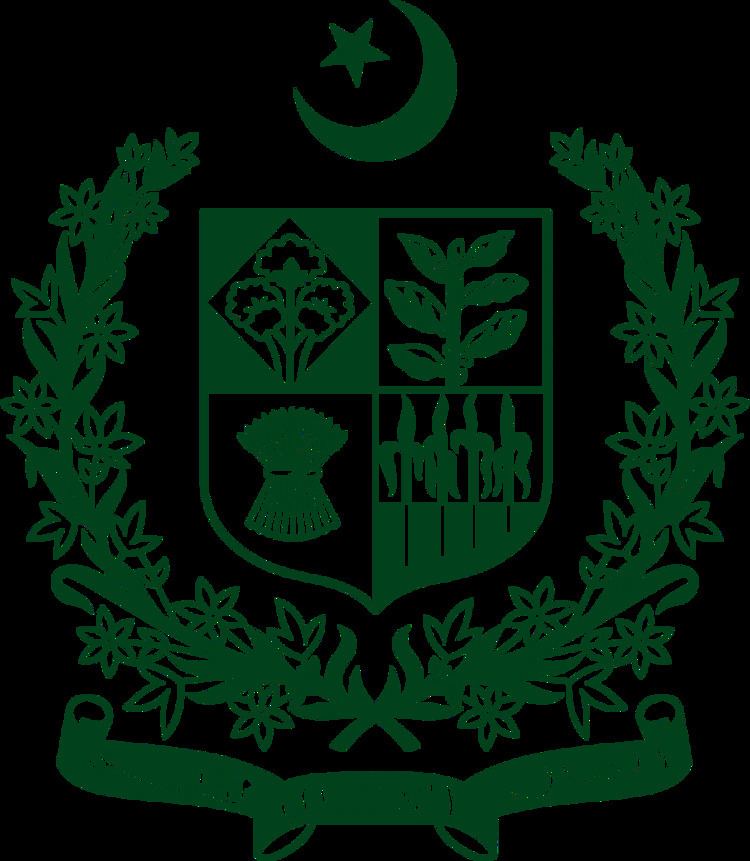Succession Second | Term length 3 years | |
 | ||
Style Mr. Chairman(Informal; while presiding the house)Honourable Chairman(Formal)Mr. President(While acting as the President) First holder Habibullah K. Marwat(12 April 1973) | ||
The Chairman of the Senate of Pakistan (Urdu: صدر ایوانِ بالا), is the president-chair of the Senate of Pakistan. According to the Constitution of Pakistan, the chairman is a presiding official and that Senate must choose a chairman and deputy chairman for a time interval of three years.
Contents
- Role and responsibilities
- History
- Relationship between Constituents of the Parliament
- List of Chairman of the Senate
- References
During the President's absence, the chairman senate is empowered with the duties of the presidency; in rare events involving the absence of the chairman, the presidential duties are usually held by Speaker National Assembly. The Chairman of the Senate is the second in the line of succession to the President of Pakistan, ahead of the Speaker National Assembly.
The Chairman of the Senate was Habibullah Marwat while Wasim Sajjad remains the longest-serving chairman. Raza Rabbani, a PPP leader and senior senator from Sindh, is the current Chairman of the Senate, having assumed office on 12 March 2015.
Role and responsibilities
The office of Chairman of the Senate is created by Article 60(1) of the Chapter 2 in Part III of the Constitution of Pakistan:
After the Senate has been duly constituted, it shall, at its first meeting and to the exclusion of any other business, elect from amongst its members a chairman and a Deputy chairman and, so often as the office of chairman or Deputy chairman becomes vacant, the Senate shall elect another member as chairman or, as the case may be, Deputy chairman
The term of office of the chairman or Deputy chairman shall be 3 years from the day on which he enters upon his office.
The main purpose for the creation of the Senate was to give equal representation to all the federating units since the membership of the National Assembly was based on the population of each four province. Equal provincial membership in the Senate, thus, balances the provincial inequality in the National Assembly and dispels doubts and apprehension, if any, regarding deprivation and exploitation.
The role of the Senate is to promote national cohesion and harmony and to alleviate fears of the smaller provinces regarding domination by any one province because of its majority, in the National Assembly.
The Senate act as an legislative institution that represents the provinces and territories of the country and promotes a feeling of equality, peace and good understanding between them, which is so essential for the growth and prosperity of a nation. Thus, the Senate in Pakistan, over the years, has emerged as an essential organ and a stabilizing factor of the federation.
History
After creation of Pakistan on 14 August 1947, the first Constituent Assembly, elected in December 1945 in undivided India, was assigned the task of framing the Constitution of Pakistan. This Assembly passed the Objectives Resolution on 12 March 1949, laying down principles which later became substantive part of the Constitution of Pakistan. However, before it could accomplish the task of framing the constitution, it was dissolved in 1954. Thereafter, the Governor General, convened the Second Constituent Assembly in 1955, which framed and passed the first Constitution of Pakistan on 29 February 1956. That Constitution was promulgated on 23 March 1956, which provided for a parliamentary form of Government with a unicameral legislature. However, from 14 August 1947 to 1 March 1956 the Government of India Act, 1935, was retained as the Constitution of Pakistan.
On 7 October 1958, Martial Law was promulgated and the Constitution abrogated. The Military Government appointed a Constitution Commission in February 1960 which framed the 1962 Constitution. That Constitution provided for a Presidential form of Government with a unicameral legislature. The 1962 Constitution was abrogated on 25 March 1969. The Civil Government, which came to power in December 1971 pursuant to 1970 elections, gave the nation an interim Constitution in the year 1972.
In 1973, the constitutional conventional framed the comprehensive Constitution which was rectify on 12 April and promulgated on 14 August 1973. Retired Senior Justice Habibullah Khan Marwat was elected its first chairman and remained until 1977. The 1973 Constitution also provided a parliamentary system of government with a bicameral legislature: the National Assembly (lower house) and the Senate (upper house). The membership of the Senate, which was originally 45, was raised to 63 in 1977 and to 87 in 1985. In 2002, the membership rose to 100 through the legal framework enforced on 21 August 2002.
Relationship between Constituents of the Parliament
The Parliament of Pakistan consists of the President and the two legislative houses: National Assembly (lower house) and the Senate (upper house).
The President is elected by members of both Houses of the Parliament and the four provincial assemblies. The President may be removed from office or impeached through a resolution, passed by not less than two-thirds of the total membership of the Parliament in a joint sitting of the two Houses, convened for the purpose. In case the office of the president becomes vacant for any reason, the chairman, or if he is unable to perform the functions of the office of the president, the Speaker, acts as president till such time that a president is elected. Same is the case when the president by reason of absence from Pakistan or any other cause is unable to perform his functions.
List of Chairman of the Senate
Independent
IJI/Muslim League (N)
Muslim League (Q)
Pakistan Peoples Party
